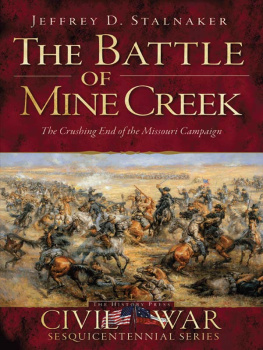This edition is published by PICKLE PARTNERS PUBLISHINGwww.picklepartnerspublishing.com
To join our mailing list for new titles or for issues with our books picklepublishing@gmail.com
Or on Facebook
Text originally published in 2002 under the same title.
Pickle Partners Publishing 2014, all rights reserved. No part of this publication may be reproduced, stored in a retrieval system or transmitted by any means, electrical, mechanical or otherwise without the written permission of the copyright holder.
Publishers Note
Although in most cases we have retained the Authors original spelling and grammar to authentically reproduce the work of the Author and the original intent of such material, some additional notes and clarifications have been added for the modern readers benefit.
We have also made every effort to include all maps and illustrations of the original edition the limitations of formatting do not allow of including larger maps, we will upload as many of these maps as possible.
The Tullahoma Campaign, The Beginning of the End for the Confederacy
by
Major Julian D. Alford USMC
EXECUTIVE SUMMARY
Thesis: The results of the Tullahoma Campaign had enormous effects on the outcome of the American Civil War. The Tullahoma Campaign was strategically more important than Gettysburg and tactically superior to Vicksburg. The Tullahoma Campaign was the beginning of the end for the Confederate cause and was a huge step in the preservation of the Union.
Discussion: The Tullahoma Campaign of 1863 is often overlooked and overshadowed by the simultaneous events of Gettysburg and Vicksburg. The results of the campaign fought by Union General William S. Rosecrans and Confederate General Braxton Bragg were strategically more significant than Gettysburg and tactically equivalent to Vicksburg. For the North, Rosecrans and his Army of the Cumberland conducted a campaign of light attacks and aggressive maneuvers that drove the Confederate Army of Tennessee completely out of the state of Tennessee. The results of the campaign for the Union formed the starting point for General William T. Shermans capture of Atlanta and his subsequent march to the sea. For the South, losing the Tullahoma Campaign and the ultimate retreat from the state of Tennessee proved to be too much from which to recover. With the loss of manpower, agricultural staples, the industrial base of the region and most importantly, the Chattanooga railroad center, the Tullahoma Campaign was the beginning of the end for the Confederacy.
Conclusion: At the beginning of the war, the Federals stated three major objectives that they needed to accomplish in order to be victorious. First, take Richmond and kill the secessionist spirit by conquering the Rebel capital. This had been attempted repeatedly but never accomplished up to this point. Second, control the Mississippi Valley and secure the western waterways. Grant had accomplished this objective by capturing Vicksburg. Finally, seize east Tennessee and hold the Nashville-Atlanta corridor, which was seen by the Federals as the major artery in the southern lifeline. Rosecrans Army of the Cumberland had achieved most of this objective in the Tullahoma Campaign and Major General William T. Sherman would finish the objective the following summer. Winning the Tullahoma Campaign and capturing Middle Tennessee was the start of obtaining the third stated objectives.
The Setting
The Tullahoma Campaign conducted in the summer of 1863 had enormous strategic results on the final outcome of the American Civil War. Often this brilliant campaign of light attacks and aggressive maneuvers to capture Middle Tennessee, conducted by Major General William S. Rosecrans and his Army of the Cumberland, is overshadowed by the simultaneous events at Gettysburg and Vicksburg. It can be argued that the results of the Tullahoma Campaign, for the Union, were strategically more important than Gettysburg and tactically superior to Vicksburg.
On June 24, 1863 the Union Army of the Cumberland began the campaign that would eventually totally divide the Confederacy. Over the next nine days, in terrible and unprecedented rainy weather, the Union Army would completely maneuver General Braxton Braggs Army of Tennessee out of Middle Tennessee. By forcing the Confederates out of the state for which they were named, the South lost the human, agricultural and industrial capacity of the region. In addition, by eventually losing the important railhead city of Chattanooga, the foundation was set for Major General William T. Shermans capture of Atlanta and his famous march to the sea less than one year later. {1}
During the campaigning season of 1863, the Union adopted three strategic objectives in order to win the war. Included were capturing the Confederate capital of Richmond, controlling the entire Mississippi River and winning the Tullahoma Campaign. Of the three stated objectives, winning the Tullahoma Campaign was the strategically most important. In doing so they would divide the Confederacy by driving a wedge in the heartland of the south, gain possession of the railhead at Chattanooga and eventually control all of East Tennessee.
Chattanooga was strategically important to both the North and the South. If possessed by the Federal Army, it would practically isolate Virginia and North Carolina on one hand and separate Mississippi and Alabama on the other. In addition, it would open the way into the interior of Georgia and the lower Atlantic region. If controlled by the Confederates, Chattanooga enabled the south to control all of eastern Tennessee, which in turn enabled them to easily move reinforcements between Virginia in the east and Tennessee and Mississippi in the west. Possession of the supply base at Chattanooga also allowed the south to constantly threaten Kentucky and the lower Ohio River region. {2}
Although Chattanooga had only 2,545 inhabitants in 1860, its importance to the north cannot be measured by its size. Situated where the Tennessee River passes through the Cumberland Mountains, forming gaps, it was called the key to East Tennessee and the gateway to the South. Chattanooga had four railroad lines radiating in four principal directions; north-northwest to Nashville, west to Memphis, south to Atlanta and the eastern seaboard, and northeast by way of Knoxville to Richmond and the eastern states.
The region of Middle and East Tennessee was also important because it was rich in grain such as wheat, corn and hay. In addition, there was an abundance of beef, pork, horses and mules. The region not only supported the Confederate Army in Tennessee, but also supplied large quantities of provisions for the southern armies in Virginia and Mississippi. {3}
From very early in the war, President Lincoln believed that the possession of Chattanooga was the gateway to the sea and a huge step towards complete victory for the Union. Many times he stated to his senior generals
East Tennessee was the key to victory. Whoever could control that mountainous piece of geography would strategically control the outcome of the conflict.
Lincoln further stated directly to General Rosecrans,
To take and hold the railroad at or east of Cleveland, in East Tennessee, I think fully as important as the taking and holding of Richmond. If we can hold Chattanooga and East Tennessee, I think the rebellion must dwindle and die. I think you and General Burnside can do this and hence doing so is your main object. {4}












